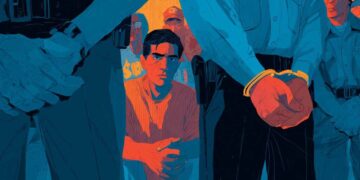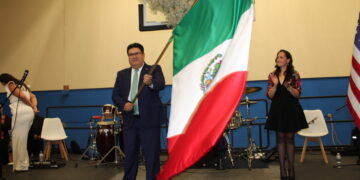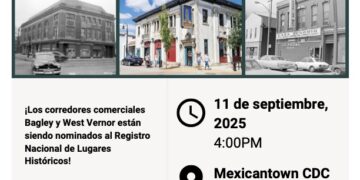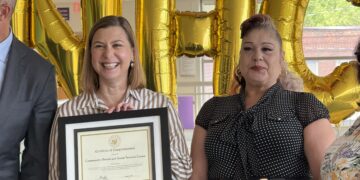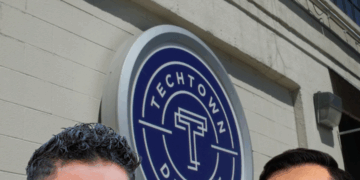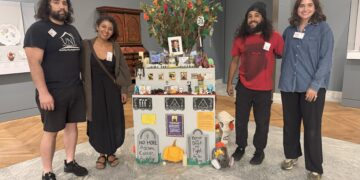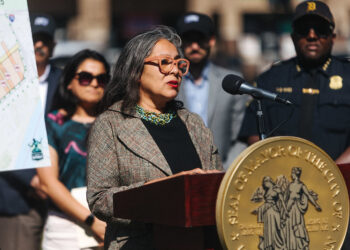A recent U.S. Supreme Court ruling in Noem v. Vasquez Perdomo has raised concerns among residents and advocates in Southwest Detroit, home to one of Michigan’s largest Hispanic communities.
In a 6–3 decision, the nation’s highest court lifted crucial restrictions on U.S. Immigration and Customs Enforcement (ICE), allowing federal agents to consider factors such as an individual’s race or ethnicity, Spanish language ability or accent, workplace, and even location on which to base immigration-related stops.
The ruling in Noem v. Vasquez Perdomo, a case originating in Los Angeles, overturned a lower court ban on such practices as grounds for detention. In her forceful dissent, Justice Sonia Sotomayor, joined by Justices Elena Kagan and Ketanji Brown Jackson, warned that the decision “opens the door to racial profiling.”
“We should not have to live in a country where the Government can seize anyone who looks Latino, speaks Spanish, and appears to work a low-wage job,” Sotomayor wrote. “Rather than stand idly by while our constitutional freedoms are lost, I dissent.”
A Community on Edge
Southwest Detroit—a cultural and economic heart with deep Mexican, Central American, and Puerto Rican roots—is feeling the fallout. Community leaders fear the Supreme Court’s action could embolden ICE and heighten the risks faced by immigrant families and their neighbors.
“The decision threatens basic civil rights,” said Angie Reyes, co-chair of MI Poder and former president of the Detroit Hispanic Development Corporation (DHDC). “Families are hesitant to shop, work, or even send their children to school.” She noted that daily life’s rhythm has been disrupted, amplifying uncertainty and anxiety.
Cindy Gamboa, executive director of MI Poder, shared her deep disappointment. “This ruling opens the door to violations of human rights simply because of our skin color or language,” she explained. Gamboa has observed shifts in everyday behaviors—more residents are carrying identification for even routine errands, out of fear of being stopped. “Families are feeling dehumanized and unsafe.”
For Lex Zavala, interim acting director at DHDC, the repercussions are personal. “Being a brown man in America and knowing that it’s now legal to racially profile me is terrifying,” Zavala said. “Taking your kids to school, going to church, or just buying groceries now feels dangerous—not because of criminals, but because of our own law enforcement agencies.”
The impact is unmistakable. Businesses in the neighborhood report declining foot traffic, school attendance has dropped, and families are withdrawing from public life. “It’s Hispanic Heritage Month, but families are too fearful to celebrate as they usually would,” Gamboa lamented. “I’m a fifth-generation U.S. citizen, and yet I feel I have to carry my passport every day just to prove I belong,” said Zavala.
Trust in law enforcement is also fraying. “A lot of crime goes unreported because people are afraid to call the police for anything,” Reyes observed. Gamboa said the ruling threatens to undo decades of effort building bridges between the community and local authorities. Zavala put it bluntly, “There is no trust. It’s unfortunate. There are good officers, but others will see this as a license to treat us as if we are not human.”
Community leaders are calling on local government to step up. “Every city should protect all its residents, regardless of where they are from,” Reyes said. Gamboa urged Detroit to distance itself from federal immigration enforcement, saying, “Our limited local resources shouldn’t be used to terrorize our own community.” Zavala agreed, adding, “Leaders at every level need to step up and do what is right.”
Residents Voice Fears
Residents of Southwest Detroit are already feeling the consequences. Irene Enriquez, a medical assistant, said, “Knowing that ICE agents can use race as a reason to stop someone makes me feel targeted.” She now worries constantly about herself, her family, and neighbors, fearing not only racial profiling and harassment but also detention and deportation.
She said that routines are already changing, with people avoiding certain public places or limiting outings. “Before, I felt that as long as I followed the rules, I wouldn’t have to think about immigration officers. Now, it feels like my appearance alone could be enough to draw suspicion.”
Kate Lopez, who works in a local school, shared similar concerns for her relatives, friends, and students. “It just makes me feel really uncomfortable that anybody can get pulled over because of the color of their skin or how they look,” she said. She explained that the ruling sends a chilling message to Hispanic families, adding, “It’s almost as though they are telling us we don’t belong here.” This uncertainty, she noted, leaves young people in Southwest Detroit questioning their place in the community.
Looking Ahead
Legal experts emphasize that the Supreme Court’s order is a temporary stay, not a final decision, but the message it sends is clear—and worrying. For many in Southwest Detroit, the future will hinge less on the courts, and more on communal response and resilience.
Community organizations like MI Poder and DHDC are already mobilizing—holding workshops, legal aid clinics, and neighborhood meetings to educate residents about their rights and foster a network of protection and solidarity. “Every city should protect all its residents,” Reyes reiterated.
Despite the heightened fear, residents are clinging to their sense of unity. “Even with all this fear, our community sticks together,” said Lopez. “Families, friends, and neighbors look out for each other, and that gives us hope.” Community leaders believe this solidarity will be pivotal in the coming months, ensuring Hispanic families continue to feel visible, valued, and supported in the city they call home.
Maxima Oxholm Barraza is a contributing writer for EL CENTRAL Hispanic News and a senior staff writer for The Oberlin Review. Her interest focuses on social justice, legal and community issues in Detroit and the Midwest. She is pursuing a degree in Law & Society and Hispanic Studies at Oberlin College.
Fallo de Corte Suprema sobre detenciones de ICE genera alarma en suroeste de Detroit
Un fallo reciente de la Corte Suprema de Estados Unidos en el caso Noem v. Vasquez Perdomo ha generado preocupación entre residentes y líderes en el suroeste de Detroit, hogar de una de las comunidades hispanas más grandes de Michigan.
En una decisión de 6-3, el máximo tribunal del país levantó restricciones clave sobre el Servicio de Inmigración y Control de Aduanas (ICE, por sus siglas en inglés), permitiendo que agentes federales tomen en cuenta factores como la raza o etnicidad de una persona, su capacidad o acento al hablar español, su lugar de trabajo e incluso su ubicación para justificar detenciones relacionadas con inmigración.
El fallo en Noem v. Vasquez Perdomo, un caso originado en Los Ángeles, revocó una prohibición de un tribunal de menor instancia sobre estas prácticas como fundamento para detener a alguien. En su firme disenso, la jueza Sonia Sotomayor, respaldada por las juezas Elena Kagan y Ketanji Brown Jackson, advirtió que la decisión “abre la puerta al perfilamiento racial”.
“No deberíamos vivir en un país donde el Gobierno pueda detener a cualquiera que se vea latino, hable español y aparente trabajar en un empleo de bajos salarios”, escribió Sotomayor. “En lugar de quedarme de brazos cruzados mientras se pierden nuestras libertades constitucionales, disiento”.
Una comunidad en tensión
El suroeste de Detroit, corazón cultural y económico con profundas raíces mexicanas, centroamericanas y puertorriqueñas, siente ya las repercusiones. Líderes comunitarios temen que la decisión de la Corte Suprema pueda envalentonar a ICE y aumentar los riesgos para familias inmigrantes y sus vecinos.
“La decisión amenaza derechos civiles básicos”, dijo Angie Reyes, copresidenta de MI Poder y expresidenta de la Detroit Hispanic Development Corporation (DHDC, por sus siglas en inglés). “Las familias dudan en ir de compras, trabajar o incluso enviar a sus hijos a la escuela”. Señaló que el ritmo de la vida cotidiana se ha visto interrumpida, amplificando la incertidumbre y la ansiedad.
Cindy Gamboa, directora ejecutiva de MI Poder, compartió su profunda decepción. “Este fallo abre la puerta a violaciones de los derechos humanos simplemente por el color de nuestra piel o por nuestro idioma”, explicó. Gamboa ha observado cambios en los comportamientos cotidianos, cada vez más residentes cargan con identificación incluso para mandados rutinarios, por temor a ser detenidos. “Las familias se sienten deshumanizadas e inseguras”.
Para Lex Zavala, director interino de DHDC, las repercusiones son personales. “Ser un hombre moreno en Estados Unidos y saber que ahora es legal hacer perfilamiento racial contra mí es aterrador”, dijo Zavala. “Llevar a tus hijos a la escuela, ir a la iglesia o simplemente comprar víveres ahora se siente peligroso, no por criminales, sino por nuestras propias agencias de seguridad”.
El impacto es innegable. Comercios del vecindario reportan menos clientes, la asistencia escolar ha bajado y las familias se están alejando de la vida pública. “Es el Mes de la Herencia Hispana, pero las familias tienen demasiado miedo de celebrarlo como normalmente lo harían”, lamentó Gamboa. “Soy ciudadana estadounidense de quinta generación, y aun así siento que tengo que llevar mi pasaporte todos los días solo para probar que pertenezco aquí”, agregó Zavala.
La confianza en las autoridades también se está debilitando. “Muchos delitos no se reportan porque la gente tiene miedo de llamar a la policía por cualquier cosa”, observó Reyes. Gamboa señaló que el fallo amenaza con deshacer décadas de esfuerzo construyendo puentes entre la comunidad y las autoridades locales. Zavala lo resumió sin rodeos: “No hay confianza. Es lamentable. Hay buenos oficiales, pero otros verán esto como un permiso para tratarnos como si no fuéramos humanos”.
Líderes comunitarios están pidiendo que el gobierno local actúe. “Cada ciudad debe proteger a todos sus residentes, sin importar de dónde provengan”, dijo Reyes. Gamboa instó a Detroit a distanciarse de la aplicación federal de inmigración, afirmando: “Nuestros recursos locales, que ya son limitados, no deberían usarse para aterrorizar a nuestra propia comunidad”. Zavala estuvo de acuerdo, agregando: “Los líderes en todos los niveles deben dar un paso al frente y hacer lo correcto”.
Voces de los residentes
Los residentes del suroeste de Detroit ya sienten las consecuencias. Irene Fuentes, asistente médica, comentó: “Saber que los agentes de ICE pueden usar la raza como razón para detener a alguien me hace sentir en la mira”. Ahora se preocupa constantemente por su familia y sus vecinos, temiendo no solo el perfilamiento racial y el hostigamiento, sino también la detención y deportación.
Dijo que las rutinas ya están cambiando, con personas evitando ciertos lugares públicos o limitando sus salidas. “Antes sentía que mientras siguiera las reglas, no tendría que pensar en los oficiales de inmigración. Ahora, parece que mi apariencia por sí sola podría ser suficiente para despertar sospechas”.
Kate López, quien trabaja en una escuela local, compartió preocupaciones similares por sus familiares, amigos y estudiantes. “Simplemente me incomoda mucho que cualquiera pueda ser detenido por el color de su piel o por su aspecto”, dijo. Explicó que el fallo envía un mensaje alarmante a las familias hispanas, agregando: “Es casi como si nos estuvieran diciendo que no pertenecemos aquí”. Esta incertidumbre, señaló, deja a los jóvenes del suroeste de Detroit cuestionando su lugar en la comunidad.
Mirando al futuro
Expertos legales enfatizan que la orden de la Corte Suprema es una suspensión temporal, no una decisión final, pero el mensaje que envía es claro y preocupante. Para muchos en el suroeste de Detroit, el futuro dependerá menos de los tribunales y más de la respuesta y resiliencia comunitaria.
Organizaciones comunitarias como MI Poder y DHDC ya se están movilizando, organizando talleres, clínicas legales y reuniones vecinales para educar a los residentes sobre sus derechos y fomentar una red de protección y solidaridad. “Cada ciudad debe proteger a todos sus residentes”, reiteró Reyes.
A pesar del miedo creciente, los residentes se aferran a su sentido de unidad. “Aun con todo este miedo, nuestra comunidad se mantiene unida”, dijo López. “Las familias, los amigos y los vecinos se cuidan unos a otros y eso nos da esperanza”. Líderes comunitarios creen que esta solidaridad será clave en los próximos meses, asegurando que las familias hispanas sigan sintiéndose visibles, valoradas y apoyadas en la ciudad a la que llaman hogar.




